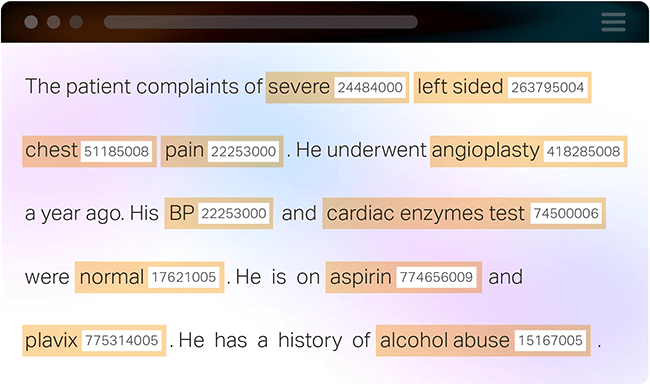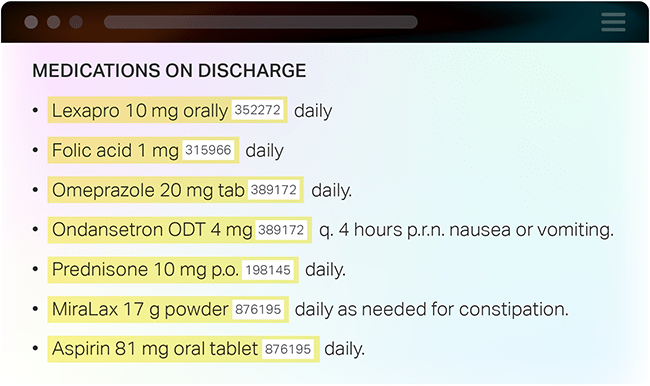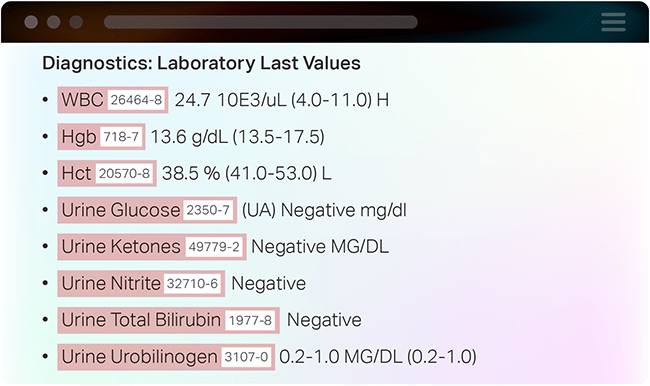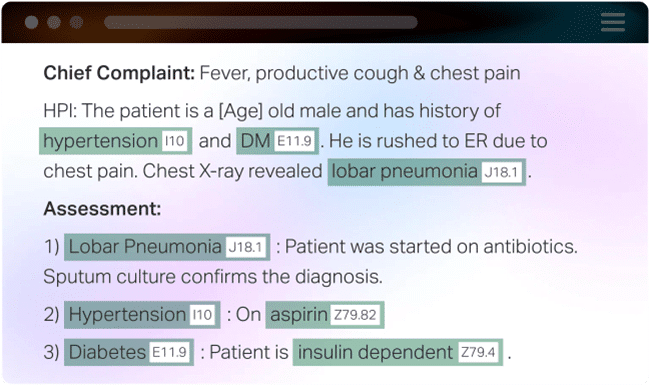Clinical Data Codification
Clinical APIs
In the realm of healthcare and medical informatics, standardized coding systems are imperative. They facilitate efficient communication across various healthcare platforms, ensuring that data is not only consistent but also accurately represented. Dive into our suite of APIs, tailored to bring standardized coding systems right at your fingertips. From understanding clinical drugs to retrieving pertinent medical codes, we have got it all covered.
Explore our suite of APIs tailored for medical informatics: the SNOMED CT API for standardized medical concepts, RxNorm for clinical drug nomenclature, LOINC for laboratory observations, and ICD-10-CM for comprehensive medical coding. Together, these tools ensure efficient, consistent, and accurate communication across various healthcare platforms.
Clinical API
SnoMed CT

The SNOMED CT API, identifies potential medical concepts as entities and associates them with standardized codes from the Systematized Nomenclature of Medicine, Clinical Terms (SNOMED-CT) ontology. The API allows for more consistent & accurate communication of medical information across different systems and stakeholders, thereby enhancing care, research, & analytics.
It focuses on discerning entities in the following categories:
- MEDICAL_CONDITION: This includes the signs, symptoms, and diagnoses associated with various medical conditions. By mapping these conditions to standardized SNOMED CT codes, the API allows for more precise and comprehensive recording of patient symptoms and diagnoses, facilitating more accurate data exchange, and enabling better patient care and health outcomes.
- ANATOMY: The API identifies & categorizes parts of the body or body systems and their locations. This feature aids in the detailed mapping of patient anatomy, which is critical for procedures like surgeries, diagnosis, and other treatments.
- TEST_TREATMENT_PROCEDURE: Various procedures, tests, and treatments utilized for the diagnosis, management, or mitigation of medical conditions. By linking these procedures to the standard SNOMED CT codes, the API promotes a detailed, structured, & consistent recording for patient care.
RxNorm
RxNorm, developed and regulated by the U.S. National Library of Medicine (NLM), is a standardized nomenclature for clinical drugs and drug delivery devices. It provides unique identifiers (RxCUIs) for medication terms, enabling efficient communication across different software platforms. Acting as a bridge, RxNorm allows translation between various terminologies used by different drug databases.

Categories that RxNorm typically handles include:
- RxNorm category: It identifies & categorizes entities under the MEDICATION category. It detects entities and associates info classified as attributes or characteristics.
- RxNorm types: Types of Medication Entities…
- BRAND_NAME: Trademarked name given to a medication or therapeutic agent by manufacturer. For example, “Advil” is a brand name for Ibuprofen.
- GENERIC_NAME: Non-proprietary name of the medication, referring to the main ingredient or the chemical composition of the drug. i.e., “Ibuprofen”.
- RxNorm traits
- NEGATION: reference suggesting that the patient not currently taking a detected medication.
- PAST_HISTORY: indicates prior medication use before the current encounter.
- RxNorm attributes
- DOSAGE: prescribed amount of the medication that the patient should take.
- DURATION: length of time over which the medication should be taken.
- FORM: physical form of the medication, such as a tablet, capsule, liquid, etc.
- FREQUENCY: how often the medication should be administered.
- RATE: indicates the speed at which the medication should be administered.
- ROUTE_OR_MODE: how the medication should be administered, i.e., orally, intravenously, etc.
- STRENGTH: concentration of the active ingredient & its strength. i.e., “200 mg” for an Ibuprofen tablet.
Logical Observation Identifiers Names & Codes (LOINC)

LOINC inspects laboratory test orders and results, unlocking medical laboratory observations . Unlock medical laboratory observations for identifiers, names & codes using NLP. The LOINC API allows interaction with the LOINC database, enabling applications to search and retrieve LOINC codes and their associated information.
Key categories in LOINC include:
- LABORATORY_TEST: This refers to any laboratory measurement or observation, ranging from a simple blood glucose test to complex genetic testing. LOINC provides unique identifiers for each tests.
- CLINICAL_REPORTS: These are documents like pathology reports, discharge summaries, or radiology reports. LOINC assigns unique identifiers to these types of reports.
- OBSERVATIONS: Measurements or simple observations related to a patient. For instance, body temperature, heart rate, or patient’s mood. Each of these observations has a unique LOINC code.
- SURVEYS: LOINC also covers surveys and questionnaires, which are frequently used in research and patient-reported outcome measures.
ICD-10-CM
The International Classification of Diseases, Tenth Edition (ICD-10), is a coding system that classifies medical conditions and procedures. It is highly accurate API for medical coding that extracts billable ICD-10-CM and PCS codes from patient encounter documents. It provides a common language that allows healthcare professionals to share and understand patient data across platforms.

Key categories in ICD-10 include:
- ICD-10 category: It identifies and categorizes entities under the MEDICATION category. It not only detects the entities but also their associated attributes or characteristics.
- ICD-10-CM attributes:
- DIRECTION: Terms indicating orientation – left, right, medial, lateral, upper, lower, posterior, anterior, distal, proximal, contralateral, bilateral.
- SYSTEM_ORGAN_SITE: The anatomical location associated with the medical condition.
- ACUITY: Characterization of the onset or duration of a disease, i.e., chronic, acute, persistent.
- QUALITY: Any descriptive attribute of the medical condition, such as its stage or grade.
- Time Expression Category: The TIME_EXPRESSION category, including dates & time such as “3 days ago,” “today,” “currently,” “day of admission,” “last month,” or “16 days.”
- ICD-10-CM traits:
- DIAGNOSIS: Medical condition based on evaluation of symptoms. It can range from common conditions like hypertension (I10) to Type 2 diabetes.
- HYPOTHETICAL: reference indicating that a medical condition is a possibility or supposition.
- LOW_CONFIDENCE: Reference suggesting medical condition is mentioned with significant uncertainty.
- NEGATION: Sign that medical condition is absent.
- PERTAINS_TO_FAMILY: An indication that a medical condition is associated with the patient’s family, rather than the patient themselves.
- SIGN: Medical condition reported by the doctor.
- SYMPTOM: Medical condition reported by patient.
- PROCEDURES: This includes codes for surgical, therapeutic, and diagnostic procedures.
Custom Healthcare
A Solution as Unique as Your Needs.
In the vast field of healthcare, unique challenges demand unique solutions. That’s why at Insights AI, we offer Custom Healthcare APIs, designed specifically for your distinct requirements, whether that means modifying an existing API or developing a new one from the ground up.
With our guidance, you can create specialized models tailored to your specific use cases. Whether it’s disease prediction, medical coding, adverse event detection, or any other healthcare application. Embrace customization and reimagine healthcare with us!
